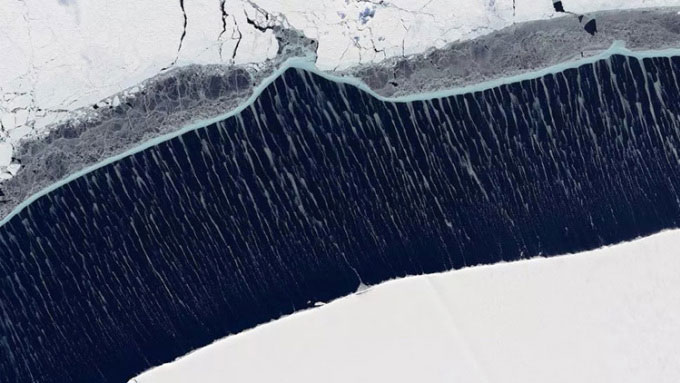Admire the rare phenomenon of 'ice tentacles' in Antarctica
Strong winds and erratic ocean currents have created a spectacular view of the water in the middle of the Ronne Ice Shelf.

Beautiful ice tentacles form on a water channel on the Ronne Ice Shelf.
This incredible image was taken by the Landsat 8 satellite on November 20, but was recently released by NASA's Earth Observatory. It shows elongated ice tendrils that look like ropes connecting the two sides of the water channel between the Ronne Ice Shelf - an extension of the Main Antarctic Ice Sheet, which spawned the world's largest iceberg A-76 in May.
Sea ice is made up of both perennial (white) and first-year, or juvenile (gray) ice. The latter is usually located much closer to the Ronne Ice Shelf, but in the image the wind has pushed it away. The wider distance allows for soft ice tendrils to form on the water channel.
Ice tentacles are basically clumps of sea ice less than 10cm thin. It is made of tiny needle-like ice crystals, also known as frazil. Normally, frazils would join together to form complete ice sheets that cover the ocean's surface, but in this case, strong winds and strange ocean currents prevented plate formation and pushed them across the ocean. the other side of the water channel, NASA explained.
However, researchers still don't fully understand why the ice tentacles in Ronne appear bluish-white when viewed from a satellite. Normally, glaciers and sea ice only show this color when they have become so dense that they absorb long wavelengths of light and reflect only blue.
"I'm not sure how the thin ice patches here get the blue color, but it's possible they've been compressed long enough to have that effect," said Walt Meier, an expert at the National Snow and Ice Data Center. US conjecture.
This stunning phenomenon could become more common in the future due to climate change, Meier added, as sea ice becomes more and more fragile and fragile.
- 'Dragon ice dragon' - super rare natural phenomenon appears in Antarctica after 10 years of disappearance
- Rare phenomenon: Antarctica persists drizzle at temperatures below 0
- Admire the extremely rare lightning in nature
- Admire the first picture of the eclipse of 1851
- Waiting for the amazing phenomenon - the most amazing total solar eclipse 99 years
- Discovered ancestor species of tentacles
- The truth about the phenomenon of
- Favorite octopus tentacles?
- Human ancestors have tentacles?
- 'Werewolf' will appear tonight?
- Find the answer to Antarctic paradox
- Hot: Waiting for the phenomenon 'Super blood moon' first appeared for 30 years
 The 11 most unique public toilets in the world
The 11 most unique public toilets in the world Explore the ghost town in Namibia
Explore the ghost town in Namibia Rare historical moments are 'colored', giving us a clearer view of the past
Rare historical moments are 'colored', giving us a clearer view of the past The world famous ghost ship
The world famous ghost ship